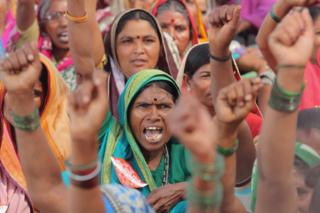Is enough support being given to India’s farmers?
The plight of India’s farmers has been a major theme in the campaigns ahead of national elections, which get under way on 11 April.
Angry farmers have regularly taken to the streets demanding a better financial deal.
Many find themselves in debt and burdened by other liabilities they’ve taken on to buy seed, fertilisers and equipment.
Thousands of farmers commit suicide every year in India, although the reasons are often complex.
Pledge: Speaking in 2016, India’s Prime Minister, Narendra Modi, said farmers’ incomes would double by 2022.
Verdict: Official data shows farmers’ incomes were rising between 2013 and 2016. Income data for the past two years is not available but there are signs the rural economy is depressed. Unless there is a significant upturn, the doubling of farm incomes by 2022 is unlikely.
The government has now pledged to pay 6,000 Indian rupees (£64) a year to help farmers with holdings of less than two hectares (20,000 sq m), in a bid to reach that goal.
These moves have been criticised by opposition parties as vote-buying ahead of the elections.
The agricultural sector employs more than 40% of the workforce in India, despite its shrinking contribution to the country’s gross domestic product (GDP), the total value of goods and services produced.
What’s happened to farming incomes?
In 2016, the average monthly income of a farming household was about 9,000 Indian rupees (£100), according to a survey conducted by the National Bank for Agriculture and Rural Development.
This report also found that farmers’ income had increased by 40% in the three years up to 2016, the latest year for which data is available.
However, there is evidence of a more recent slowdown in the rural economy.
According to one estimate, farm income, which had grown by more than 14% in the year to 2017, slumped to just over a 2% growth rate between 2017 and 2018.
And in several state elections in December 2018, the ruling BJP fared poorly – something put down to growing discontent in rural areas.
What problems do farmers face?
Droughts, bad weather and a lack of modern equipment have plagued Indian agriculture for decades.
In addition, many of India’s farmers work on vulnerable small or marginal holdings.
The current administration has introduced pro-farming policies that include:
But it’s also faced criticism for other policies that have negatively affected farmers – such as the sudden decision to 2016 withdraw the 500 and 1,000 rupee notes from circulation in a bid to tackle the black economy.
Why aren’t farmers earning more?
A very good harvest in any year will result in a sharp fall in the price of a commodity.
This helps keep food prices in check for urban consumers but is not so good for rural producers.
To counter this, the government sets a minimum purchase price for major agricultural products each year.
However, a recent official report pointed out serious shortcomings of these price controls.
It cited a lack of awareness among farmers, delays in payments and insufficient facilities to enable farmers to store produce at government-controlled warehouses.
At various times over the years, national and state governments have also announced loan waivers for farmers to write off their debts.
These schemes are expensive and not everyone qualifies for help.
Read more from Reality Check
Send us your questions
Follow us on Twitter
Source: Read Full Article



